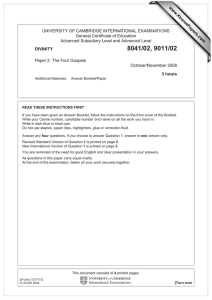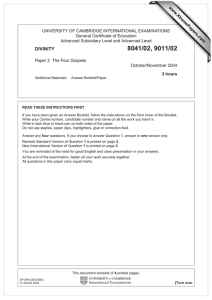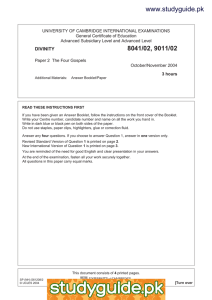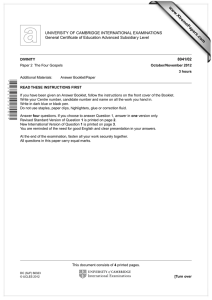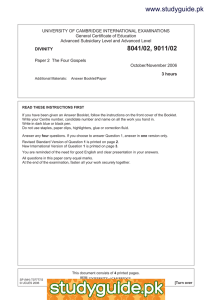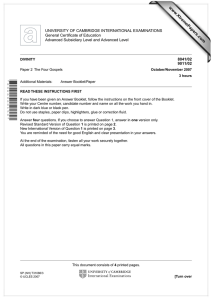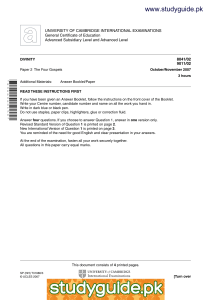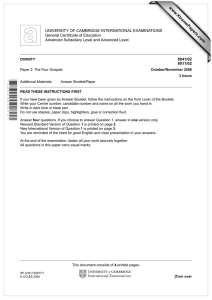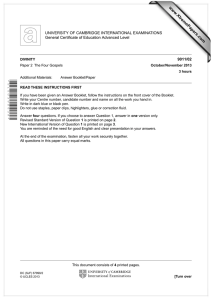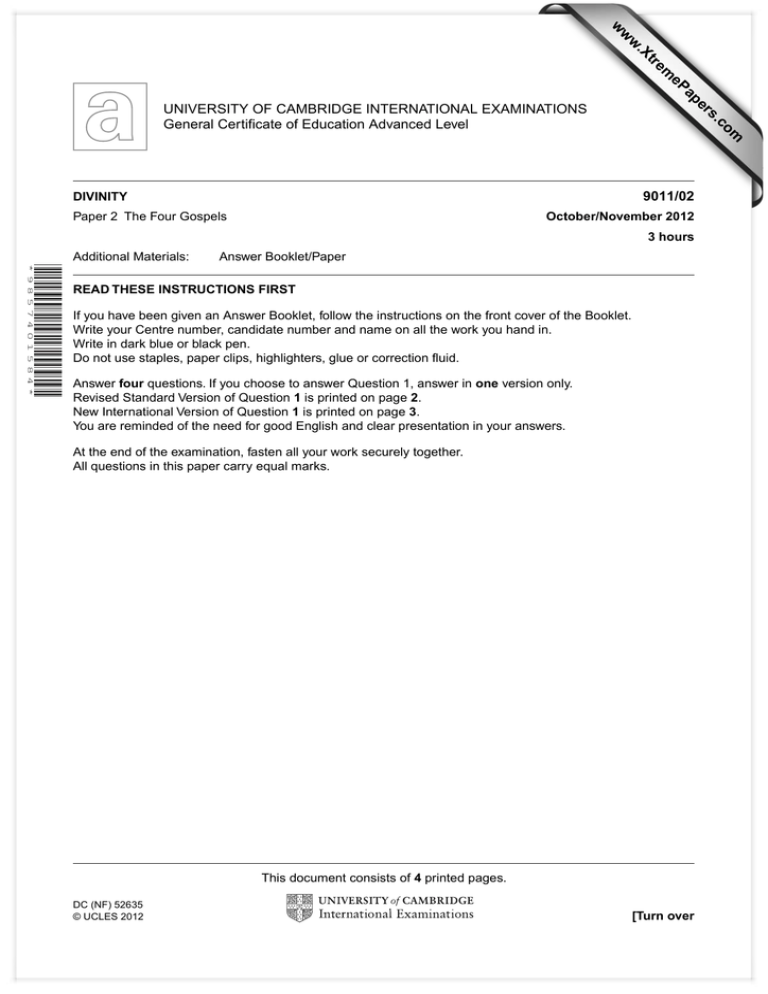
w
w
ap
eP
m
e
tr
.X
w
om
.c
s
er
UNIVERSITY OF CAMBRIDGE INTERNATIONAL EXAMINATIONS
General Certificate of Education Advanced Level
9011/02
DIVINITY
Paper 2 The Four Gospels
October/November 2012
3 hours
Additional Materials:
Answer Booklet/Paper
* 9 8 5 7 4 0 1 5 8 4 *
READ THESE INSTRUCTIONS FIRST
If you have been given an Answer Booklet, follow the instructions on the front cover of the Booklet.
Write your Centre number, candidate number and name on all the work you hand in.
Write in dark blue or black pen.
Do not use staples, paper clips, highlighters, glue or correction fluid.
Answer four questions. If you choose to answer Question 1, answer in one version only.
Revised Standard Version of Question 1 is printed on page 2.
New International Version of Question 1 is printed on page 3.
You are reminded of the need for good English and clear presentation in your answers.
At the end of the examination, fasten all your work securely together.
All questions in this paper carry equal marks.
This document consists of 4 printed pages.
DC (NF) 52635
© UCLES 2012
[Turn over
2
REVISED STANDARD VERSION
1
Comment on points of interest or difficulty in four of the following passages (wherever possible
answers should refer to the context of the passage but should not retell the story from which the
passage is taken).
[25 marks]
(a) Now when Jesus was born in Bethlehem of Judea in the days of Herod the king, behold, wise
men from the East came to Jerusalem …
(Matthew 2:1)
(b) And when Jesus finished these sayings, the crowds were astonished at his teaching, for he
taught them as one who had authority, and not as their scribes.
(Matthew 7:28–29)
(c) And he awoke and rebuked the wind, and said to the sea, “Peace! Be still!” And the wind
ceased, and there was a great calm.
(Mark 4:39)
(d) And they said to him, “Grant us to sit, one at your right hand and one at your left, in your
glory.”
(Mark 10:37)
(e) But woe to you that are rich, for you have received your consolation.
(f)
(Luke 6:24)
And when he had said this, he went on ahead, going up to Jerusalem. When he drew near
to Bethphage and Bethany, at the mount that is called Olivet, he sent two of the disciples …
(Luke 19:28–29)
(g) And his disciples asked him, “Rabbi, who sinned, this man or his parents, that he was born
blind?”
(John 9:2)
(h) I am the door; if any one enters by me, he will be saved, and will go in and out and find
pasture.
(John 10:9)
© UCLES 2012
9011/02/O/N/12
3
NEW INTERNATIONAL VERSION
1
Comment on points of interest or difficulty in four of the following passages (wherever possible
answers should refer to the context of the passage but should not retell the story from which the
passage is taken).
[25 marks]
(a) After Jesus was born in Bethlehem in Judea, during the time of King Herod, Magi from the
east came to Jerusalem.
(Matthew 2:1)
(b) When Jesus had finished saying these things, the crowds were amazed at his teaching,
because he taught as one who had authority, and not as their teachers of the law.
(Matthew 7:28–29)
(c) He got up, rebuked the wind and said to the waves, “Quiet! Be still!” Then the wind died down
and it was completely calm.
(Mark 4:39)
(d) They replied, “Let one of us sit at your right and the other at your left in your glory.”
(Mark 10:37)
(e) “But woe to you who are rich,
for you have already received your comfort.”
(f)
(Luke 6:24)
After Jesus had said this, he went on ahead, going up to Jerusalem. As he approached
Bethphage and Bethany at the hill called the Mount of Olives, he sent two of his disciples,
saying to them …
(Luke 19:28–29)
(g) His disciples asked him, “Rabbi, who sinned, this man or his parents, that he was born blind?”
(John 9:2)
(h) I am the gate; whoever enters through me will be saved. He will come in and go out, and find
pasture.
(John 10:9)
© UCLES 2012
9011/02/O/N/12
[Turn over
4
2
Assess the view that Matthew’s gospel presents Jesus as the New Moses.
[25]
3
Discuss the authorship of Matthew’s gospel.
[25]
4
“In Mark’s gospel the disciples are far from perfect.” Discuss.
[25]
5
Examine Mark’s use of the term ‘Son of Man’ in his gospel.
[25]
6
Consider the role played by John the Baptist in Luke’s gospel.
[25]
7
To what extent can it be argued that Luke’s gospel was written for a Gentile community?
[25]
8
“John’s gospel was written to interpret and improve the synoptic gospels.” Discuss.
[25]
9
Examine the part played by women in John’s gospel.
[25]
10 Assess the importance of the accounts of the Last Supper in the Gospels.
[25]
11 Assess the reasons why Judas betrayed Jesus.
[25]
12 Examine the arguments for the existence of Q as a separate source for Matthew and Luke.
[25]
13 To what extent can it be said that the Gospel writers show Jesus as totally rejecting violence? [25]
14 Discuss the purpose of the parables in the gospels.
[25]
Copyright Acknowledgements:
Scripture quotations marked (RSV) are from the Revised Standard Version of the Bible, copyright © 1946, 1952 and 1971 by the Division of Christian Education
of the National Council of the Churches of Christ in the USA. Used by permission. All rights reserved.
Scripture quotations marked (NIV) are taken from the Holy Bible, New International Version®. NIV®. Copyright © 1973, 1978, 1984 by International Bible Society.
Used by permission. All rights reserved.
Permission to reproduce items where third-party owned material protected by copyright is included has been sought and cleared where possible. Every reasonable
effort has been made by the publisher (UCLES) to trace copyright holders, but if any items requiring clearance have unwittingly been included, the publisher will
be pleased to make amends at the earliest possible opportunity.
University of Cambridge International Examinations is part of the Cambridge Assessment Group. Cambridge Assessment is the brand name of University of
Cambridge Local Examinations Syndicate (UCLES), which is itself a department of the University of Cambridge.
© UCLES 2012
9011/02/O/N/12


